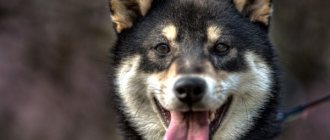Calm and even breathing of an animal is one of the markers of your pet’s health. Accordingly, if a dog suddenly begins to choke, this causes alarm to the owner. On the other hand, such physiological changes can be provoked by active jogging, prolonged exposure to heat or a stuffy room. Breathing problems may occur during sleep, before or during childbirth . In dogs of brachycephalic breeds, snoring during sleep is due to the specific structure of the nasopharynx and is not considered a deviation from the norm.
Causes of heavy breathing
In a normal physiological state, dogs breathe exactly at a rate of 12-30 movements per minute. The smaller the breed, the more frequently the dog will breathe. The rate of breathing can change during physical activity or stress. In a number of physiological conditions (pregnancy, excitement, feeding), the rhythm may increase. But all these changes cannot be called heavy breathing in a dog, since they do not last long and have a compensatory function that does not exceed the physical capabilities of the animal.
It’s another matter when the dog’s body experiences difficulty breathing. This happens due to a variety of reasons:
- heat stroke, which occurs when a dog overheats in the warm season (especially common since there are no sweat glands);
- heart failure, common in older dogs;
- infectious pathologies are accompanied by inhibition of all body functions;
- intoxication – chocolate and alcohol are dangerous for dogs;
- pain reaction;
- hypoglycemia due to metabolic disorders;
- state of shock with serious injuries, large blood loss.
Rare deep breathing is characteristic of the near-death state. In dogs, there is a long period of apnea, followed by a convulsive strong breath. The rhythm is usually disturbed, the intervals between breaths are uneven.
Determining the cause of heavy breathing is necessary to fully treat the animal. But before starting a clinical and instrumental examination, the dog’s condition should be brought back to normal. Emergency care is aimed at restoring blood volume, body temperature and, most importantly, respiratory function.
When to see a veterinarian
Remember, an animal may pant heavily after exercise, excitement, or when it is hot. Call your veterinarian immediately if any of the following occur:
- Your dog's panting starts suddenly.
- You think your dog might be in pain.
- He is suffocating constantly and intensely.
- Your dog's tongue or gums appear blue, purple, or white - a sign that your pet is not getting enough oxygen.
^Top
Diagnostic methods
To assess the animal's condition, the respiratory rate should be measured. The rhythm of the movement is noted, and it is important to determine what type of breathing is used - chest, abdominal or mixed. The abdominal type of breathing is not typical for dogs and occurs with serious pathological disorders of the respiratory organs - pneumothorax, hydrothorax.
A sick animal shakes, stretches its neck and head. In a serious condition, he lies or stands with his limbs apart. Breathing is wheezing through the mouth with increased work of the abdominal muscles. General state of anxiety, only in stupor there is no reactivity.
Differential diagnosis:
- with hyperthermia (heat and sunstroke), convulsions, increased salivation, tremors, and coma appear;
- heart failure is accompanied by a drop in blood pressure, arrhythmia, and tremors;
- bacterial and viral pathologies are characterized by an increase in temperature by 1.5-3 degrees above normal, damage to the respiratory and digestive systems;
- intoxication is accompanied by vomiting and diarrhea;
- In case of injuries in dogs, severe pain reaction, bleeding, damage to the integument, bones, and internal organs are noted.
Snoring and whistling sounds during inhalation occur with spasm and blockage of the upper respiratory tract. A similar pathology of the lower respiratory tract is characterized by wheezing on exhalation. If the lung tissue is damaged (pneumonia, edema), wheezing, squelching sounds are detected by auscultation.
If the dog is breathing heavily and frequently with wheezing, external respiratory function should be assessed. To determine this parameter, a blood gas analysis is required. There are several technologies. Pulse oximetry measures hemoglobin levels, which indirectly indicates the oxygen content in arterial blood.
Capnography works on a completely different principle. In this case, the air exhaled by the dog is analyzed, in which the concentration of carbon dioxide is determined. The measurement is taken after intubation and is the most accurate way to accurately assess a dog's respiratory function.
Signs
Characteristic manifestations of shortness of breath are:
- increased movement of the chest/abdomen;
- flaring of the nostrils;
- breathing with an open mouth;
- elbows widely spaced;
- the neck is stretched forward;
- noisy breathing.
In cases where shortness of breath is caused by life-threatening causes - pulmonary edema, pneumothorax, airway obstruction, the following symptoms can be observed:
- the dog cannot breathe;
- breathing is very shallow, frequent, so that chest movements are not visible;
- stridor (“hoarse” loud breathing when inhaling);
- change in color of mucous membranes - crimson/blue/gray.
With such symptoms, the dog needs emergency help.
Principles of emergency and therapeutic care
Quickly assessing the animal's condition, stabilizing it and returning it to normal is the key to successfully treating panting. Depending on the lesion, treatment can be medicinal (bronchodilators, corticosteroids) or surgical (tracheostomy, tracheotomy, thoracentesis). In most cases, oxygen therapy is necessary - artificial ventilation is performed during diagnostic and therapeutic measures.
Emergency help:
- determination of respiratory rate - if it decreases, intubation is carried out with the introduction of oxygen;
- rapid breathing, accompanied by whistling sounds and severe depression, indicates obstruction of the respiratory tract - it is necessary to administer corticosteroids and anesthesia;
- surgical intervention is performed to eliminate the cause of the obstruction;
- removal of foreign bodies is carried out under general anesthesia;
- if accumulation of fluid and gases in the chest cavity is suspected, thoracentesis is performed;
- After stabilization of the serious condition, the examination of the animal is completed.
Most often, heavy breathing is observed before the death of an animal. This is a dangerous pathological sign that indicates serious negative changes in the dog’s body. Therefore, it is so important to quickly help the animal, even without making a full diagnosis. Compensation of vital functions in this case is a more necessary step than treatment of the etiological factor.
After eliminating the threat to the dog’s life, you can resort to treatment for the underlying disease. Antibiotics, sulfa drugs, interferon, and immunoglobulins are prescribed to increase resistance and suppress infections. Novocaine blockades with the addition of antibiotics have a great positive effect - they block the stellate ganglion and suprapleural nerve nodes. This allows you to stop the pain reaction and suppress the microflora.
They stop the dog’s pain reaction and lower the temperature. For this purpose, analgin and baralgin are used. Eliminate bronchospasms using bronchodilators. Expectorants are used together with them. Antihistamines are indicated to avoid complications in the dog.
Tachypnea (rapid breathing in dogs)
symptoms
When dogs breathe faster than circumstances require, they are said to have tachypnea.
- your breathing rate is higher than normal with your mouth closed or open;
possible reasons
- anemia (low red blood cell count);
- hypoxemia (low oxygen levels in the blood);
- asthma;
- tumors;
- pulmonary edema or heart failure;
- internal bleeding into the lungs;
Call a veterinarian Moscow
+7(495)162-70-70
Features of the prevention of respiratory pathologies
A variety of reasons can lead to heavy breathing in a dog, so preventive measures come down to maintaining health and a high level of resistance in the animal.
The first thing to pay attention to is feeding your pet. A complete diet provides your dog with proteins, fats, carbohydrates, vitamins and minerals. This is the main component of the formation of immunity. The level of feeding is affected by the breed, age, sex and weight of the animal. You should not overfeed your pet, as this also negatively affects metabolism and undermines resistance.
In terms of maintenance, guard dogs suffer more than others. Cold in winter, high humidity in autumn and drafts are the main predisposing factors in the development of respiratory pathologies. In the summer, dogs kept outside often suffer from heatstroke. Therefore, you should provide the dog with a booth that protects it from all weather conditions.
Infectious agents also cause damage to the respiratory system. Pathologies of other systems also lead to heavy breathing. Regular vaccination, early diagnosis and treatment will help avoid complications in dogs. To maintain health, dogs need to be dewormed. But it is important not to forget that the thoughtless use of veterinary drugs leads to intoxication and allergic reactions, which are also included in the etiological factors of difficulty breathing.
How can I help my dog?
If an animal is experiencing an attack of “reverse sneezing,” in which the dog inhales sharply through the nose and cannot exhale, sometimes it is enough to stroke the throat or simply pinch the nose so that the pet takes a deep breath with its mouth. If breathing problems are caused by a stressful situation, then it is advisable to give the dog special sedatives on the recommendation of a doctor.
If difficulty breathing is caused by a foreign object getting into the nasopharynx, then you can try to remove it yourself, while acting with the utmost caution. However, it is still worth showing the animal to a specialist at a veterinary clinic to eliminate or confirm suspicions of polyps, neoplasms in the nasopharynx, dirofilariasis, heart problems, and infectious diseases.
A standard examination is not always sufficient to make a diagnosis. You may need to conduct an X-ray, electrocardiographic or ultrasound examination, clinical and biochemical blood test. Immunodiagnostic tests and testing for parasites will help rule out dirofilariasis.
Thus, a foreign object stuck deep in the throat is most often removed using an endoscope or surgical intervention is performed. In case of swelling of the larynx caused by an allergic reaction, injections of antihistamines are necessary; heart nematodes are destroyed with special medications. The doctor will prescribe antibacterial and vasodilator drugs if the dog is diagnosed with a cold , pneumonia, viral rhinotracheitis, or parainfluenza.
If you see that your pet is choking, you should definitely show it to a specialist as soon as possible. Veterinary clinics of the Aibolit Plus network are open for you 24 hours a day, please contact us. The health of your pet is in your hands.
Asthma symptoms – what should you look out for?
It is impossible to fully describe the signs of bronchial asthma in dogs. The fact is that the clinical picture differs depending on the breed of the animal. However, there are still general symptoms, and one of the most common is heavy or “wheezing” breathing (sounds when inhaling and exhaling have different pitches). It occurs due to the formation of a film of dense connective tissue (adhesions) in the lungs.
The main signs indicating the development of asthma in an animal:
- wheezing and strange sounds (whistles, gurgling) when inhaling and exhaling,
- cough (may have sputum),
- cardiopalmus,
- mucus discharge from the nose,
- general weakness,
- decreased activity, etc.
Noticed a few symptoms of asthma in your pet? Do not hesitate - contact a veterinary clinic for diagnosis. The doctor will examine the dog and, if necessary, prescribe additional tests.
Prevention of poisoning
Prevention of poisoning in a dog should be based on developing in it the concept that it is forbidden to pick up edible objects from the ground, as well as take food from the hands of strangers. During a walk, it is better to walk the dog on a short leash and carefully monitor its behavior.
If the dog has not learned to ignore food on the street, it is necessary to put a muzzle on it.
The basis for the general prevention of poisoning in dogs is biologically complete feeding of dogs, taking into account their physiological state, providing them with active walks and maintaining good sanitary condition and microclimate in the place where the dog is kept. Owners should exclude low-quality and unusual food from their dog’s diet (confectionery, sweets, foods high in fat and spices, canned food, dry food and sausages). It is strictly prohibited to feed dogs pork, lamb, and sometimes fish. The food fed to dogs should not contain mechanical impurities, nitrates, nitrites, herbicides, stabilizers, drugs and other toxic substances. Dogs should always have plenty of fresh, clean water at room temperature. The feeding diet must be balanced both in terms of the set of feeds and the sugar-protein ratio, macro-microelements, vitamins (basics of feeding dogs, feeding pregnant females, feeding lactating dogs, feeding aging dogs, feeding puppies, golden rules of rational feeding of dogs) .
With proper feeding, the dog will not experience a deficiency in any substance and will stop looking for it on its own, trying food that is unfamiliar and sometimes dangerous for it.
Treatment
It is best if the causes of tachypnea are identified and eliminated. This, for example, could be heat, stress or physical activity.
Symptomatic therapy is advisable in situations where the cause of rapid breathing is not obvious and time is needed to find it.
Oxygen therapy will have a positive effect on the animal, especially if its condition is assessed as severe.
Infusion therapy is used to treat dehydrated animals or dogs suffering from systemic diseases such as uremia.











